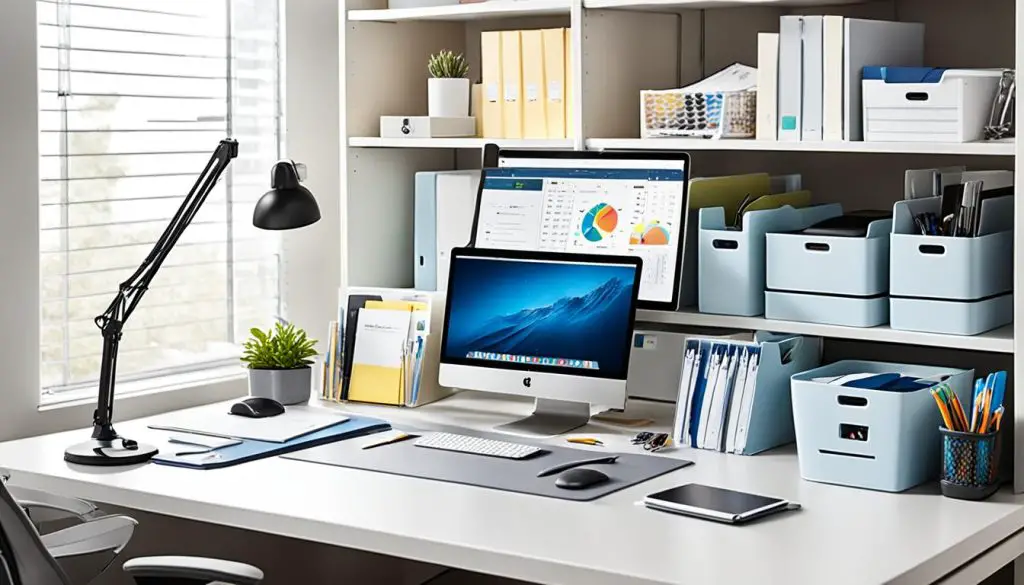Living with a chronic illness, I’ve found ways to set up a great home office. 1 I hope my experience helps you find what works for you. This guide is for anyone facing daily challenges, wanting a balanced life, or looking for more inclusive work spaces.
Here’s an important question to think about: Can a home office truly empower productivity and well-being for those living with debilitating conditions? My wife struggles with endometriosis and fibromyalgia. I’ve seen how a well-designed home office can make a big difference. Let’s look at some practical ideas that changed my work life and could help you too.
The Challenges of Working with Chronic Illness
Managing a chronic illness takes a lot of effort.2 It’s hard to wake up early, go to work, and sit at a desk all day. This makes my chronic pain and tiredness worse. Many people hide their illnesses because they fear what others might think.
Lack of Flexibility in Traditional Office Environments
3 Lots of skilled people with disabilities want to work. But, they face a big hurdle. Most jobs need them to work from 9 to 5, which isn’t always possible when health is unpredictable.
Managing Daily Symptoms and Fatigue
Sitting too much can cause a lot of pain. This includes issues with the neck, back, and wrists. It’s vital to teach bosses and coworkers about setting up workspaces right and taking breaks to move. This helps fight off pain from work.
The Benefits of a Customized Home Office
Setting up a home office has really boosted how well I work and feel.4 Now, I skip the daily drive and I’m not worried about what others might think if I need to stretch or use the bathroom. My day is my own, moving with my energy levels, and I work from my cozy spot at home.
Ergonomic Setups for Comfort and Productivity
Creating an ergonomic workspace helps me sit well and reduces aches. I use a standing desk that I can adjust, keep the lighting just right, and control the temperature. This means my work area is comfy and helps me get more done. I can also choose when to work best, not just when I have to. It’s made balancing my work and life a lot better.
Flexible Schedules and Work-Life Balance
Moving regularly is key for desk workers like me. I do simple stretches and take short exercise breaks to keep my body in good shape. It helps me not only feel better but work better too.
Practical Home Office Chronic Illness Solutions
Setting up a proper home office can really change things for those with long-term health issues. We can find new ways to be productive, comfortable, and balanced by making adjustments. This can include getting furniture that moves, making sure the lighting and temperature are right, and using smart tools to work better. The goal is to make our workspaces fit our health needs.
A big plus of working from a customized home office is managing how we feel each day better.5 We skip the travel and strict work hours, working when our energy is high. We can rest whenever we need it and find comfort in treating our discomfort. This way, we don’t push ourselves too hard physically or mentally, as offices might do.
It’s important to have an office that’s set up correctly for our bodies.5 Things like desks and chairs that move, as well as lighting that’s not too harsh, can make a big difference. They help us sit, stand, and work without hurting our bodies. Good setups mean we work better and are less likely to hurt ourselves over time.
Having a spot in our office just for relaxing can benefit our minds and feelings a lot too.5 Places like a cozy reading corner with soft plants can be a great escape. They help us unwind and get ready to tackle our to-dos with more focus and energy.
The secret to a great home office for those with ongoing health issues is in being adaptable, focusing on how the space fits us, and staying healthy.5 Whether it’s picking the right parts for our office or managing our energy well, we can make a part of our home that truly supports us. This allows us to do our best work and be happier in general.
Designing an Ergonomic Workspace
Setting up an ergonomic home office is vital for comfort and work quality.6 With adjustable standing desks and chairs, I keep a good posture and reduce stress on my body. They help me switch between sitting and standing easily, which keeps me active.6
Adjustable Standing Desks and Chairs
Getting the right lighting and temperature in my office is key. I avoid strong overhead lights and set up natural light options. Being able to change the room temperature is also crucial. This combo cuts down eye strain and helps me focus better.
Proper Lighting and Temperature Control
It might cost some cash to set up an ergonomic area, but it’s worth it for less pain and more work done. Adding simple tools like desk organizers and special chairs can greatly improve your day.
Organizing for Efficiency and Accessibility
For those of us with chronic illnesses, a tidy and easy-to-use home office is key.7 It helps us work better and handle daily tasks. With so many Americans facing multiple health issues,7 setting up a workspace that meets our needs is vital.
The first thing I did was organize my office. I set up a system to find papers, medical records, and work stuff easily. Getting adjustable shelves and drawers made a big difference. It means I can get what I need without hurting myself.
Getting rid of clutter and distractions is also crucial for me.7 Since people with multiple health problems are at most risk and need more hospital care,7 having a neat workspace is important. By going digital, using a good filing system, and keeping my supplies tidy, I’ve made my office a peaceful place. It boosts my work and fights off tiredness from my chronic illness.
| Accessibility Feature | Benefit |
|---|---|
| Adjustable Shelving | Enables easy access to frequently used items, reducing physical strain |
| Labeled Storage Containers | Promotes organization and quick retrieval of necessary documents and supplies |
| Ergonomic Desk and Chair | Supports proper posture and minimizes discomfort during prolonged sitting |
| Wireless Keyboard and Mouse | Allows for flexible positioning and movement, reducing wrist and hand strain |
By setting up an orderly and accessible office, my work and health have improved.7 Since most healthcare and medicine spending is by people like us, having the right work set-up is smart. It helps us manage our health better and do well in our jobs.

Incorporating Relaxation Spaces
In my home office, I set up special areas to relax. There’s a warm reading spot with cozy chairs and gentle lights. It’s perfect for when I want a break from work.8
Cozy Reading Nooks
I placed low-light plants in my office to make it peaceful. These plants not only improve the air but also boost my mood. They’re great for reducing stress too.9
Low-Light Houseplants
I learned it’s okay to take breaks and refresh in these spots. This has really helped me deal with tiredness and keeping my energy up. It’s like hitting a reset button before getting back to work.10
Leveraging Productivity Tools and Apps
I’ve discovered the power of home office productivity tools and time management apps. They’ve greatly improved how I work.11 These tools keep me on track and focused. Plus, noise-canceling headphones help me block out distractions for better concentration.
These aids are especially useful for people with ongoing health struggles. They enable us to use our energy and focus efficiently.11 With help from technology, I organize tasks better. This lets me work more when I’m feeling my best.
Technology at work boosts health, job enjoyment, and how much we get done. True, buying ergonomic gear and tech can be a bit expensive at first. Yet, the benefits in efficiency, comfort, and work-life balance are well worth it in the end.
Managing Energy Levels and Fatigue
Living with a chronic illness means always fighting to keep my energy up and avoid fatigue. I use the “Spoon Theory” to wisely plan my day.12 This theory involves assigning a number of “spoons” to tasks. It helps me pace myself and not do too much in one day.12
The Spoon Theory and Activity Pacing
Along with the Spoon Theory, I focus on moving and adding short exercise breaks to my day. Things like stretching or taking a quick walk around my home boost my mood and ease any physical pains.
Incorporating Movement and Exercise Breaks
Staying active is key for my body and mind, even when working from home. It’s important to move often, either at my desk or by taking short exercise breaks. This helps with muscle pains and keeps my energy up.
Seeking Accommodations and Support
Getting the support and help I needed has been my focus. It’s improved my job life a lot.13 Working from home and setting my own hours have helped. They let me handle my ongoing health issues better without the usual office limits.13
Disability Accommodations and Flex Work Policies
I also looked into ways to make work fit my health needs better. This includes using telehealth services.13 With good healthcare and doctor visits from home, I feel lucky and supported.
Telehealth Services and Online Support Groups
Joining online communities for people like me has been great. I’ve found friends and more ways to cope. Talking and sharing with others who understand has made a big difference. It makes me feel stronger.
Embracing Remote Work Opportunities
Working from home full-time has changed everything for me, especially managing my chronic illness. With this setup, I can take breaks when I need to and deal with pain without worrying about what others might think.14 Finding jobs that are both flexible and home-based significantly shaped my career path. Roles like freelance writing, being a virtual assistant, and making online content matched my skills and health requirements well.
Finding Flexible and Home-Based Roles
Creating a strong online presence helped me a lot in getting remote work. A detailed website, active social media, and a strong portfolio drew in clients and bosses interested in what I could do, no matter where I worked from.
Building an Online Presence and Portfolio
Thanks to remote work, I’m excelling in my career while making sure my health comes first. The freedom to set up my work life around my wellness, rather than a desk, is incredibly liberating.14
If you’re looking for more remote job chances, jobs that let you work from home, or ways to strengthen your online portfolio, the rise of remote work has given us with chronic illnesses many new options. This modern approach to working lets us craft careers that support our work output and health at the same time.14
Advocating for Workplace Inclusivity
Many employers find it hard to grasp the challenges faced by those with chronic illnesses. It’s crucial to teach them about the daily struggles and necessary accommodations. These can boost both work performance and health.15
Educating Employers on Chronic Illness Challenges
Increasing awareness and empathy about disabilities in the workplace is vital. This happens by speaking about personal experiences and pushing for supportive policies. Doing this can change attitudes and make the workplace more understanding.
Promoting Disability Awareness and Empathy
Companies that focus on helping their employees and are flexible and trusting do better with their chronically ill staff. Transforming the nature of work to be more inclusive lets organizations benefit from a wide range of skills.

Fostering a Positive Mindset and Self-Care
Handling8 chronic illnesses, keeping a positive view, and self-care are key to my happiness. Living with8 chronic pain and8 fatigue taught me this. A strong mindset and self-care help me do well even in remote work.16
I use the freedom of working from home to my advantage. I’ve crafted a workspace that suits me. Yet, it’s crucial to set limits and find time to relax. Self-care like reading, caring for plants, or taking small exercise breaks really helps my health.
Dealing with chronic sickness is tough, but positivity and help can light the way. I share my journey to encourage others. I hope to guide those facing similar battles to find office support. Together, we can make a workspace that boosts health.
| Key Strategies for Fostering a Positive Mindset and Self-Care |
|---|
|
By setting my mind and actions on positivity and self-care, I excel in my home office. I balance work and life, even with8 chronic8 illnesses.16 This full approach betters my work output, satisfaction, and life quality.
Conclusion
On my journey, I’ve learned that keeping a positive mindset is key. Remote work has given me the chance to design my work area at home. It meets my needs perfectly. But, it’s crucial to set clear rules and find time for rest.
Dealing with chronic illness has its hardships. Yet, with the right approach and support, excelling in a remote job is achievable. I aim to encourage others with tips from my journey. I want to help them stand up for their needs and create a work environment that boosts their success and health.17
Companies that value the skills of those with chronic illnesses and offer help stand out. They can attract talented staff. This is possible by welcoming policies and practices. Let’s work together to build an open and fair job world for everyone.17
Source Links
- https://optimize.health/
- https://www.myshortlister.com/insights/chronic-illness-in-the-workplace
- https://www.ncbi.nlm.nih.gov/pmc/articles/PMC7006125/
- https://www.apartmenttherapy.com/how-chronically-ill-people-make-home-comfortable-36950267
- https://agingwithdignity.org/news/plug-into-innovative-solutions-for-managing-chronic-illnesses
- https://theadvancedspinecenter.com/the-ergonomic-approach-designing-your-workspace-for-spine-health/
- https://www.ncbi.nlm.nih.gov/pmc/articles/PMC8515222/
- https://www.julieannrachelle.com/blended-decor-blog/wellness-design-for-chronic-illness
- https://www.ncbi.nlm.nih.gov/pmc/articles/PMC8871637/
- https://k2space.co.uk/knowledge/office-design-ideas
- https://healthyworkplaces.berkeley.edu/health-technology-workplace-leveraging-technology-protect-and-improve-worker-health-0
- https://www.lifeofpippa.co.uk/2019/05/20/aids-and-equipment-for-managing-fatigue-ad/
- https://www.colefisher.com/blog/chronic-illness-and-employer-obligations
- https://www.linkedin.com/pulse/embracing-remote-work-empowering-individuals-chronic-illness-boyd-rn
- https://blog.peoplefirstjobs.com/5-ways-to-support-employees-who-are-disabled-or-chronically-ill/
- https://www.ncbi.nlm.nih.gov/pmc/articles/PMC6917929/
- https://www.ncbi.nlm.nih.gov/pmc/articles/PMC3222510/
